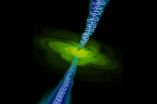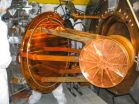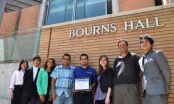(Press-News.org) PHILADELPHIA — Advances in the understanding of the genetics of coronary artery disease, or CAD, will revitalize the field and lead to more therapeutic targets for new medicines to combat this common disease, suggests a genetics expert from the Perelman School of Medicine at the University of Pennsylvania in a Perspective article in the new issue of Science Translational Medicine.
Daniel J. Rader, MD, chair of the Department of Genetics and associate director of the Institute for Translational Medicine and Therapeutics, asserts that the lagging search for new heart medicines could be jump-started by a wide-angle hunt for relevant genetic variants in humans.
According the America Heart Association, the death rate from heart disease has fallen about 39 percent during the past 10-most-recent years for which statistics are available. Still, heart disease is the number-one cause of death in the United States, killing almost 380,000 people a year.
Although progress has been made in decreasing the risk of heart disease, with the single greatest contribution made by statins to reduce levels of low-density lipoprotein cholesterol (LDL-C) in millions of people, the burden of the disease remains high. "Despite this clear unmet need, however, many biopharmaceutical companies have begun to back away from efforts to discover and develop therapies for this prevalent disease," writes Rader, citing seven drugs that have failed in phase 3 clinical trials in the last three to five years.
The single biggest issue facing the development of new therapeutics for heart disease is confidence before expensive human trials are underway that the target of a new drug has a high probability of success in reducing disease. Animal models of atherosclerosis, however, have not proven reliable at predicting new therapies that are effective in humans. In contrast, Rader says, basing drug targets on human genetics can provide greater confidence that a therapeutic targeted to a particular pathway will show clinical benefit in reducing major cardiovascular events in people. As with recent successes in cancer immunotherapy, a targeted, personalized approach to developing new treatments has proved attractive to big pharma.
Human genetic data strongly support the concept that reducing LDL-C by any means is associated with a lower cardiovascular risk. This association is consistent with LDL-C being a causal factor in the development of cardiovascular disease. Indeed, the discovery that mutations in the gene PCSK9 reduce LDL-C and protect against CAD launched a major effort to develop inhibitors of PCSK9, which markedly reduce LDL-C and are in late-stage clinical development.
Similar genetic data for triglycerides were recently published, suggesting that specific proteins regulating this blood chemical might be viable therapeutic targets. On the other hand, human genetic data provide little support for raising high-density lipoprotein cholesterol (HDL-C) because genetic variants associated with increased HDL-C are not generally associated with decreased cardiovascular risk.
Although circulating biomarkers such as LDLs and triglycerides, commonly measured in standard blood lipid panels, are useful for guiding drug development programs focused on reducing CAD, Rader contends that many of the genetically validated targets for CAD will not have well-established circuiting biomarkers. "Some of the most interesting new targets for atherosclerotic cardiovascular disease are likely to come from genetic studies of common and rare variants, comparing individuals with early disease with those who are free of disease," says Rader.
He cites studies of common variants associated with CAD that have yielded nearly 50 discrete genetic loci genome-wide that are statistically significantly associated with CAD. Less than a third are associated with such traditional risk factors as LDL-C levels or blood pressure, leaving more than 30 loci with no association with traditional measureable risk factors.
Rader cites a 2011 Lancet study, performed in collaboration with Penn colleague Muredach P. Reilly, MBBCH, MSCE, associate professor of Medicine and Pharmacology, that identified a new locus, ADAMTS7, a gene already implicated in arthritis, which was associated with the risk of developing CAD.
ADAMTS7 is a metalloproteinase, an enzyme expressed in blood vessels. Rader suggests that if it could be shown that genetically reduced activity of ADAMTS7 protects against CAD, this would provide compelling support for the concept of pharmacologically inhibiting this enzyme: "Situations like this, in which loss-of function gene variants are associated with protection from CAD, are particularly compelling because they suggest that pharmacologic inhibition of those proteins might be expected to reduce risk."
The wealth of new genetic discoveries over the past several years, combined with additional ones likely to come, has provided potential new targets and has caught the attention of the biopharmaceutical industry, notes Rader. Indeed, the Accelerating Medicines Partnership, a partnership between the National Institutes of Health and 10 biopharmaceutical companies (Rader co-led the working group for type 2 diabetes), was recently formed to leverage human genetics to discover and validate new therapeutic targets.
INFORMATION:
Penn Medicine is one of the world's leading academic medical centers, dedicated to the related missions of medical education, biomedical research, and excellence in patient care. Penn Medicine consists of the Raymond and Ruth Perelman School of Medicine at the University of Pennsylvania (founded in 1765 as the nation's first medical school) and the University of Pennsylvania Health System, which together form a $4.3 billion enterprise.
The Perelman School of Medicine has been ranked among the top five medical schools in the United States for the past 17 years, according to U.S. News & World Report's survey of research-oriented medical schools. The School is consistently among the nation's top recipients of funding from the National Institutes of Health, with $392 million awarded in the 2013 fiscal year.
The University of Pennsylvania Health System's patient care facilities include: The Hospital of the University of Pennsylvania -- recognized as one of the nation's top "Honor Roll" hospitals by U.S. News & World Report; Penn Presbyterian Medical Center; Chester County Hospital; Penn Wissahickon Hospice; and Pennsylvania Hospital -- the nation's first hospital, founded in 1751. Additional affiliated inpatient care facilities and services throughout the Philadelphia region include Chestnut Hill Hospital and Good Shepherd Penn Partners, a partnership between Good Shepherd Rehabilitation Network and Penn Medicine.
Penn Medicine is committed to improving lives and health through a variety of community-based programs and activities. In fiscal year 2013, Penn Medicine provided $814 million to benefit our community.
Genetics provide blueprint for new heart disease therapies
2014-06-04
ELSE PRESS RELEASES FROM THIS DATE:
UCLA researchers identify new gene involved in Parkinson's disease
2014-06-04
A team of UCLA researchers has identified a new gene involved in Parkinson's disease, a finding that may one day provide a target for a new drug to prevent and potentially even cure the debilitating neurological disorder.
Parkinson's disease is the second most common neurodegenerative disorder after Alzheimer's disease, and there is no cure for the progressive and devastating illness. About 60,000 Americans are diagnosed with Parkinson's disease each year. It is estimated that as many as 1 million Americans live with Parkinson's disease, which is more than the number ...
Drones give farmers an eye in the sky to check on crop progress
2014-06-04
CHAMPAIGN, Ill. — This growing season, crop researchers at the University of Illinois are experimenting with the use of drones – unmanned aerial vehicles – on the university's South Farms.
Dennis Bowman, a crop sciences educator with U. of I. Extension, is using two drones to take aerial pictures of crops growing in research plots on the farms. He presented his findings to farmers and other researchers at the 2014 Ford / Iroquois County Agronomy Day meeting.
Bowman intentionally made mistakes on one test plot – "areas where we didn't apply enough nitrogen fertilizer, ...
Increase in number of total knee replacement surgeries, especially in younger adults, linked to obesity
2014-06-04
ROSEMONT, Ill.─The number of total knee replacement (TKR) surgeries more than tripled between 1993 and 2009, while the number of total hip replacements (THR) doubled during the same time period. A study appearing in the June Journal of Bone and Joint Surgery (JBJS) found that an increase in the prevalence of ovrweight and obesity in the U.S. accounted for 95 percent of the higher demand for knee replacements, with younger patients affected to a greater degree.
"We observed that growth of knee replacement volumes was far outpacing that of hip replacements and were ...
Surprisingly strong magnetic fields challenge black holes' pull
2014-06-04
A new study of supermassive black holes at the centers of galaxies has found magnetic fields play an impressive role in the systems' dynamics. In fact, in dozens of black holes surveyed, the magnetic field strength matched the force produced by the black holes' powerful gravitational pull, says a team of scientists from the U.S. Department of Energy's Lawrence Berkeley National Laboratory (Berkeley Lab) and Max Planck Institute for Radio Astronomy (MPIfR) in Bonn, Germany. The findings are published in this week's issue of Nature.
"This paper for the first time systematically ...
No evidence of the double nature of neutrinos
2014-06-04
Neutrinos are tiny, neutral elementary particles that, contrary to the standard model of physics, have been proven to have mass. One possible explanation for this mass could be that neutrinos are their own antiparticles, so-called Majorana particles.
Though experimental evidence for this is still lacking, many theoretical extensions of the standard model of physics predict the Majorana nature of neutrinos. If this hypothesis proves to be true, many previously unanswered questions about the origin of our universe and the origin of matter could be answered.
650 meters ...
NASA sees Depression Boris mOVING over Mexico with heavy rainfall
2014-06-04
Tropical Depression 2E strengthened into Tropical Storm Boris briefly on June 3 before making landfall in southern Mexico and weakening into a depression. While Boris was building to tropical storm strength, NASA's Aqua and TRMM satellites passed overhead identifying heavy rainfall and the extent of the storm.
On June 3 at 19:15 UTC (3:15 p.m. EDT) the Moderate Resolution Imaging Spectroradiometer (MODIS) instrument aboard NASA's Aqua satellite captured a visible image of Tropical Storm Boris over Central America. Boris appeared circular in the imagery and its clouds ...
Scientist uses fossils to prove historic Ohio millstones have French origins
2014-06-04
Cleveland . . . A geologist studied fossils to confirm that stones used in 19th century Ohio grain mills originated from France. Fossils embedded in these millstones were analyzed to determine that stones known as French buhr were imported from regions near Paris, France, to Ohio in the United States.
Dr. Joseph Hannibal, curator of invertebrate paleontology at The Cleveland Museum of Natural History, was lead author on research published in the Society for Sedimentary Geology journal PALAIOS.
The study documents a technique that uses fossils to definitively distinguish ...
Cleaning the air with roof tiles
2014-06-04
RIVERSIDE, Calif. (http://www.ucr.edu) — A team of University of California, Riverside's Bourns College of Engineering students created a roof tile coating that when applied to an average-sized residential roof breaks down the same amount of smog-causing nitrogen oxides per year as a car driven 11,000 miles.
They calculated 21 tons of nitrogen oxides would be eliminated daily if tiles on one million roofs were coated with their titanium dioxide mixture. They also calculated it would cost only about $5 for enough titanium dioxide to coat an average-sized residential roof.
That ...
Mayo Clinic researchers decode how the brain miswires, possibly causing ADHD
2014-06-04
JACKSONVILLE, Fla. — Neuroscientists at Mayo Clinic in Florida and at Aarhus University in Denmark have shed light on why neurons in the brain's reward system can be miswired, potentially contributing to disorders such as attention deficit hyperactivity disorder (ADHD).
They say findings from their study, published online today in Neuron, may increase the understanding of underlying causes of ADHD, potentially facilitating the development of more individualized treatment strategies.
The scientists looked at dopaminergic neurons, which regulate pleasure, motivation, ...
GW Cancer Institute conducts survey on moving toward quality patient-centered care
2014-06-04
WASHINGTON (June 4, 2014) — In order to meet new cancer program accreditation standards, institutions have placed new focus on patient navigation, psychosocial distress screening, and survivorship care plans. Recently published research by the George Washington University (GW) Cancer Institute found these new programs are experiencing "growing pains." The results of a nationwide survey conducted by the GW Cancer Institute and reviewed in the Journal of Oncology Navigation and Survivorship, found that health care professionals could most benefit from greater evaluation of ...






